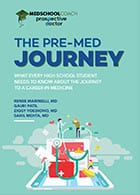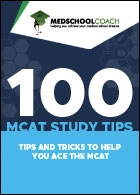
Table of Contents
Most early action (EA) and early decision (ED) application deadlines for undergraduate admission are November 1. Early actions and decision choices typically come out by December 15, though every school’s calendar may look a little different.
I’m Renee Marinelli, MD. I’ve helped hundreds of students achieve their goals in medical education. Let me explain more about ED and EA if you’re a high school student applying to college and plan on following a pre-med track.
(Looking for information about early decision when applying to medical school? Dr. Sahil Mehta and I also wrote a detailed guide with everything you need to know.)
Looking to get into a top pre-med undergrad program? Team up with a college admissions expert to craft a standout application and strategic school list so you can take the next step as a prospective doctor.
What is early decision? ED is a binding agreement between a student and undergraduate institution in which the college or university accepts a student around mid-December in exchange for the student’s guaranteed attendance. Students with a good shot at early decision have excellent academic scores and extracurriculars and want to attend a specific school.
What is early action? Although some institutions use “early action” interchangeably with “early decision,” non-restrictive early action means you can apply early to a school and hear back early. It’s not as binding as early decision. You can usually say no to an early action admission acceptance letter.
Every school has slightly different guidelines, so I always recommend checking their website or calling their admissions office for more details. Some of the best pre-med schools have first-year ED programs, including Northwestern and Boston University. Harvard and Yale have restrictive single-choice early action. UNC Chapel Hill and Georgetown have non-restrictive EA.
Read below to learn more about whether early decision or early action is right for you.
Watch This Free Webinar: How to optimize your common app & get into top pre-med programs
Is Early Decision a Good Decision?
If you know what pre-med school you want to go to, I would say early decision is a good decision for you. These are the primary benefits of applying early decision:
- Increased acceptance chances
- Earlier notification of acceptance
- Showing off your time management skills
- Demonstrating your dedication to a specific school
The drawbacks of early decision include the binding nature of the ED application, meaning you cannot say no to their offer of admission. Also, the tighter timeline and restriction on fallback pre-med applications compared to regular decision applicants can increase your stress levels.
Read Next: What High Schoolers Should Know About Med School
What Are the Benefits of Early Action?
Early action is typically non-binding — though you should definitely check the school’s unique guidelines — but there are still upsides compared to regular decision. Below, I’ve written out the main benefits of non-restrictive early action:
- Slightly increased acceptance chances
- Earlier decision notification
- Demonstrating time management skills
- Fewer restrictions on applying elsewhere, compared to ED
The downsides are increased pressure to decide on your first choice pre-med program, inability to compare financial aid packages, and a more stressful time crunch.
What are the best pre-med majors? Get your answers here.
Early Decision/Early Action Timeline
Here’s the basic timeline of applying early decision or early action for high school students looking to go into pre-med.
Read More: Planning Ahead for Med School in the 10th Grade
January-May of Junior Year
- Take the SAT or the ACT.
- Visit colleges during spring break. If you’re struggling to pick your top-choice college, check out our lists of the best non-Ivy League schools for pre-meds and the best pre-med programs in the United States.
Summer After Junior Year
- Get a head start on the application process, such as drafting a personal essay.
- Narrow down where you want to apply. For most early decision applications, you can only apply to one school, and the application is binding. Choose wisely.
August-November of Senior Year
- Work on regular decision college applications, but don’t send them in. Many early decision programs make you agree not to apply to other colleges, so it would be unethical to submit these applications. But if you don’t get into your ED college, you’ll usually only have 2 weeks to apply for regular decision, so it’s good to have applications in your back pocket.
- At the beginning of the school year, have teachers, coaches, or other mentors write recommendations for your college application. You want to give them a few weeks.
- If you haven’t already, take the SAT or ACT. October is usually the last available test date in time for early decision and early action. I suggest you take it the previous year so you have the option to retake it and improve your test scores, so this really applies to students looking to improve their scores with a retake.
- File early decision or early action applications according to school deadlines and procedures. Typically, the ED and EA deadline is November 1.
December of Senior Year
- Most colleges notify their early decision and early action applicants of their acceptance status in late December, typically December 15. If necessary, compare offers.
- If you are accepted, congratulations! Keep working hard on your final semester, but you can rest assured you are an admitted student.
- If you are not accepted, you have at least two weeks to apply regular decision. Hopefully, you have some additional college applications mostly filled out. (There are plenty of good schools that accept applications after January 1, including rolling admission processes.)
Read Next: Planning Ahead for Med School in 11th and 12th Grade
What’s Early Decision II?
Many colleges offer early decision I, but a few also offer early decision II, which is more flexible. EDII deadline is typically late January to mid-February. EDII is also binding, so you still need to pick your top choice school.
The EDII acceptance rate isn’t as high as during the EDI admissions cycle, but the time stressors are reduced.
More Tips for Going Into Pre-Med
Are you in high school and considering a medical career? The High School Alliance of Future Physicians (HSAFP) can help you prepare before starting college. MedSchoolCoach partners with HSAFP to offer aspiring pre-meds plenty of resources for nailing their college admissions process and succeeding during undergrad for the best shot at a medical school acceptance.
Have you considered a BS/MD dual-degree admission plan? Here, an undergrad school partners with an affiliated med school to provide high school seniors with conditional acceptance into medical school. Essentially, you get accepted into both your undergrad and medical programs at the same time.
A limited number of these B/MD and Early Assurance medical programs even allow students to skip the MCAT. Find out which programs don’t require testing.
The major drawback of B/MD programs is that they are highly competitive – most of these dual degree programs accept only a few students per year. Only those with top-notch GPA, SAT or ACT scores, and clinical and research experience should consider applying.
Our college admissions experts & physician advisors are here to help you get into a top undergrad or B/MD program. Schedule a free session with our enrollment team to learn more about how MedSchoolCoach can help you succeed in the admissions process.

Renee Marinelli, MD
Dr. Marinelli has practiced family medicine, served on the University of California Admissions Committee, and has helped hundreds of students get into medical school. She spearheads a team of physician advisors who guide MedSchoolCoach students.





